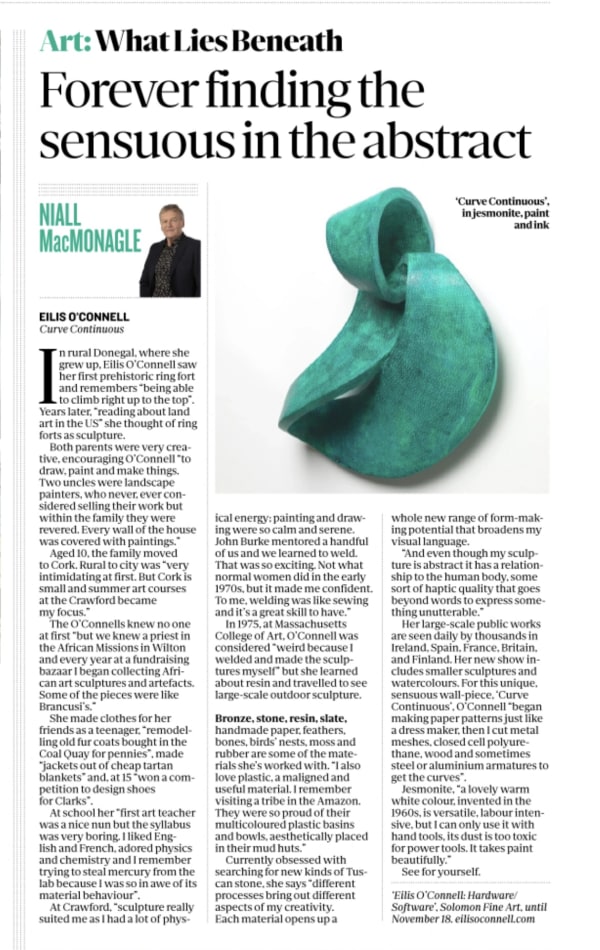Forever finding the sensuous in the abstract
Art: EILIS O'CONNELL
What Lies Beneath
NIALL MACMONAGLE
In rural Donegal, where she grew up, Eilis O'Connell saw her first prehistoric ring fort and remembers "being able to climb right up to the top”. Years later, "reading about land art in the US” she thought of ring forts as sculpture.
Both parents were very creative, encouraging O'Connell "to draw, paint and make things. Two uncles were landscape painters, who never, ever considered selling their work but within the family they were revered. Every wall of the house was covered with paintings.”
Aged 10, the family moved to Cork. Rural to city was "very intimidating at first. But Cork is small and summer art courses at the Crawford became my focus.”
The O'Connells knew no one at first "but we knew a priest in the African Missions in Wilton and every year at a fundraising bazaar I began collecting African art sculptures and artefacts. Some of the pieces were like Brancusi's.”
She made clothes for her friends as a teenager, "remodelling old fur coats bought in the Coal Quay for pennies”, made "jackets out of cheap tartan blankets” and, at 15 "won a competition to design shoes for Clarks”.
At school her "first art teacher was a nice nun but the syllabus was very boring. I liked English and French, adored physics and chemistry and I remember trying to steal mercury from the lab because I was so in awe of its material behaviour”.
At Crawford, "sculpture really suited me as I had a lot of physical energy; painting and drawing were so calm and serene. John Burke mentored a handful of us and we learned to weld. That was so exciting. Not what normal women did in the early 1970s, but it made me confident. To me, welding was like sewing and it's a great skill to have.”
In 1975, at Massachusetts College of Art, O'Connell was considered "weird because I welded and made the sculptures myself” but she learned about resin and travelled to see large-scale outdoor sculpture.
Bronze, stone, resin, slate, handmade paper, feathers, bones, birds' nests, moss and rubber are some of the materials she's worked with. "I also love plastic, a maligned and useful material. I remember visiting a tribe in the Amazon. They were so proud of their multicoloured plastic basins and bowls, aesthetically placed in their mud huts.”
Currently obsessed with searching for new kinds of Tuscan stone, she says "different processes bring out different aspects of my creativity. Each material opens up a whole new range of form-making potential that broadens my visual language.
"And even though my sculpture is abstract it has a relationship to the human body, some sort of haptic quality that goes beyond words to express something unutterable.”
Her large-scale public works are seen daily by thousands in Ireland, Spain, France, Britain, and Finland. Her new show includes smaller sculptures and watercolours. For this unique, sensuous wall-piece, 'Curve Continuous', O'Connell "began making paper patterns just like a dress maker, then I cut metal meshes, closed cell polyurethane, wood and sometimes steel or aluminium armatures to get the curves”.
Jesmonite, "a lovely warm white colour, invented in the 1960s, is versatile, labour intensive, but I can only use it with hand tools, its dust is too toxic for power tools. It takes paint beautifully.”
See for yourself.


